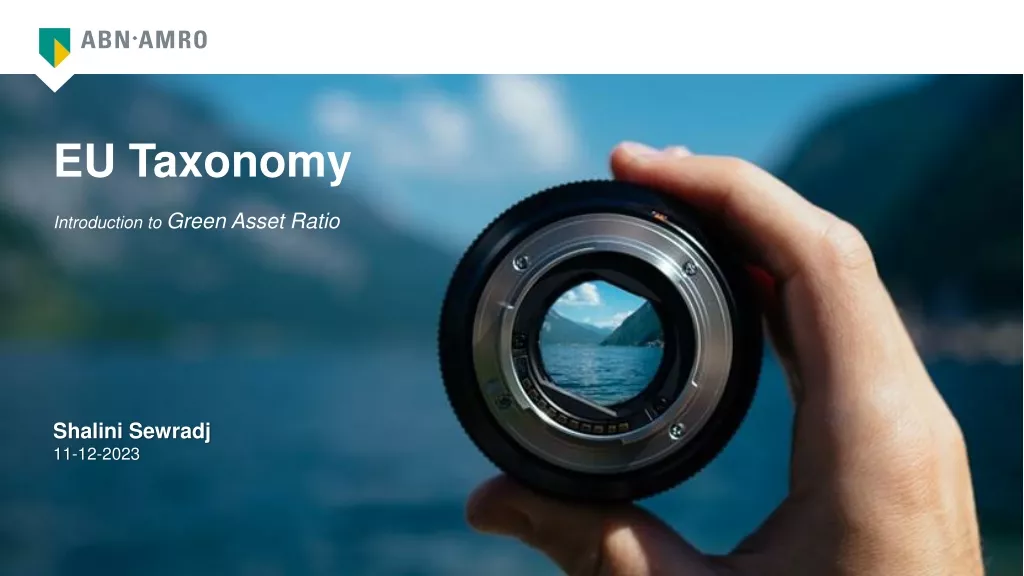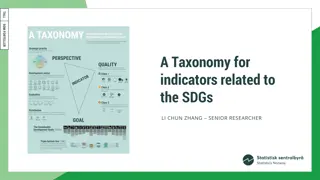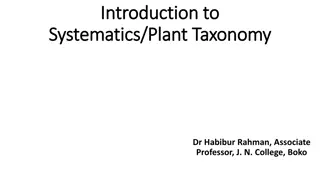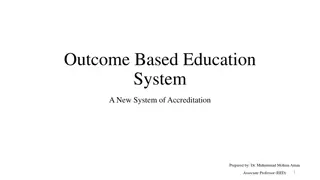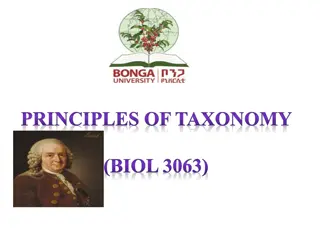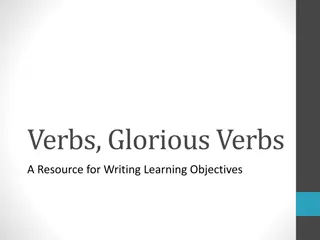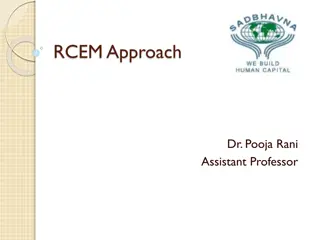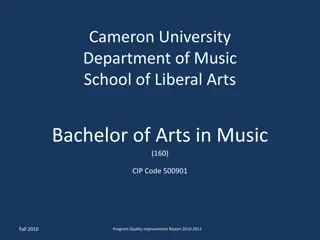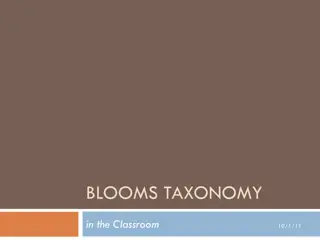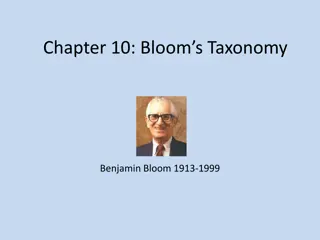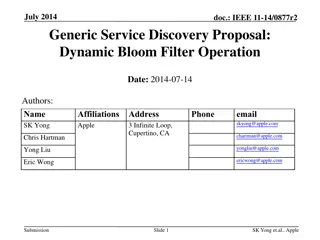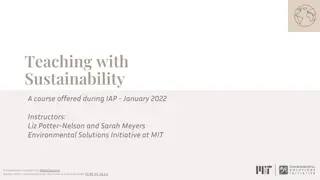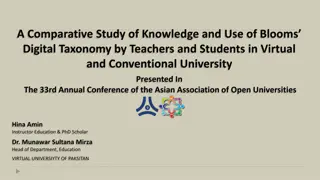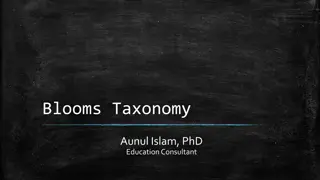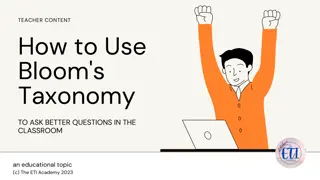Bloom's Taxonomy and Educational Objectives
Explore the comprehensive concept of Bloom's Taxonomy and Educational Objectives developed by Prof. Benjamin S. Bloom and his associates. Learn about the cognitive, affective, and psychomotor domains, instructional objectives, and the interrelation of educational activities in shaping learners. Discover how these theories shape teaching and learning processes for optimal development.
Download Presentation

Please find below an Image/Link to download the presentation.
The content on the website is provided AS IS for your information and personal use only. It may not be sold, licensed, or shared on other websites without obtaining consent from the author.If you encounter any issues during the download, it is possible that the publisher has removed the file from their server.
You are allowed to download the files provided on this website for personal or commercial use, subject to the condition that they are used lawfully. All files are the property of their respective owners.
The content on the website is provided AS IS for your information and personal use only. It may not be sold, licensed, or shared on other websites without obtaining consent from the author.
E N D
Presentation Transcript
WELCOME BY KAVITA SRIVASTAVA
BLOOMS TAXONOMY
WORD TAXONOMY DERIVED FROM THE GREEK WORD TAXIS MEANS SYSTEMATIC CLASSIFICATION
.Prof. Benjamin S. Bloom and his associates, University of Chicago developed and classified the domains of Educational Objectives. . Bloom (1956) presented his taxonomy related to cognitive domain giving emphasis to the hierarchy of cognitive process in attaining knowledge and development of thinking. Later, Krathwhol (1964) introduced affective domain and Simpson (1966) developed Psychomotor domain. This classification of objective is known as Bloom s taxonomy of Educational Objectives.
EDUCATIONAL OBJECTIVES OBJECTIVES INSTRUCTIONAL OBJECTIVES
EDUCATIONAL OBJECTIVES Related with those desirable behavioural changes whose field is wide, extensive and general Relation is not directly with teaching- learning process but with the whole of education Nature is formal, indirect and theoretical Long period of time is necessitated for their attainment
INSTRUCTIONAL OBJECTIVES Pre determined learning outcome of an instruction The specific or immediate goal which is obtainable as a result of instruction or through classroom instruction Target of a teacher for a specific lesson or a topic Narrow, Specific, Definite, Tangible, Precise, Clear & Functional
CLASSIFICATION OF BLOOM S TAXONOMY 1. COGNITIVE DOMAIN Knowledge Field 2. AFFECTIVE DOMAIN Feeling Field 3. PSYCHOMOTOR DOMAIN Doing Field
Every educational activity should be planned to develop all this domain of the learner hence All three domains are mutually interrelated and interdependent also
COGNITIVE DOMAIN IT COVERS HEAD - MIND In this domain, only those educational objectives are included which are concerned with Knowledge, Recognition and Recall
B.S.Bloom has divided objectives related to cognitive domain into six categories - 1956 2001 KNOWLEDGE COMPREHENSION APPLICATION ANALYSIS SYNTHESIS EVALUATION REMEMBERING UNDERSTANDING APPLYING ANALYZING EVALUATION CREATING COGNITIVE DOMAIN
. Lowest level in the Cognitive Domain KNOWLEDGE . It includes the ability of students to recall and remember the information learned in the classroom . Second level in the Cognitive Domain COMPREHENSION . It is the meaningful recall &recognition of the learned content. . Here the learner could understand and explain what he learned in the classroom as his own language
. Third level in the Cognitive Domain APPLICATION . It is the ability to apply the acquired knowledge through instruction in real life situations. . It is the meaningful breakdown of the materials into its various components and to identify the interrelationship between the elements and find out how they are organized and related. ANALYSIS . Specification of this level includes the analysis of elements, analysis of relationship, analysis of organizational principles.
. It is the mental ability of the learner to integrate the acquired , comprehended, applied and analyzed knowledge into a comprehensive whole. SYNTHESIS . It involves the ability to give a new shape or structure to statements or procedures. . Highest level of Cognitive Domain. . Students could evaluate an object, person, a theory or a principle if only s/he is par with all other lower hierarchy in the cognitive domain. EVALUATION .At this level s/he could perform personal viewpoint about the information.
AFFECTIVE DOMAIN IT COVERS HEART It is concerned with interests, emotions, appreciations, attitudes, values, feelings etc. of the pupil.
The Objectives of Affective Domain are - RECEIVING RESPONDING VALUING ORGANISATION CHARACTERISATION AFFECTIVE DOMAIN
. In the basic level the learner is sensitized to the existence of a certain phenomena and stimuli. RECEIVING . s/he is willing to receive the information whole heartedly by exhibiting awareness on the stimuli and become conscious on particular person, principle, philosophy, incidents etc. . Efective reception prepares the learner to respond seriously. RESPONDING . As result of receiving some good message from the first hierarchy, the learner tries to respond to the situation positively.
. By responding in good ways, the students set guidelines for their behaviour. VALUING . Accepting values, preference for values, commitment to values are the important behavioural changes in this level. . Student builds a system of value at this level. Value conflict and value crisis are resolved. ORGANIZATION . Through organizing different values students are able to develop their own code of conduct and standard of public life in society.
CHARACTERIZATION . This is the biggest level of internalization process. Values are imbibed and forms part of the life style of the individual. . For example, the non violence values becomes the philosophy of the individual. They will not ready to compromise on their philosophy at any stage as well as, ready to work for justice even though they are alone their way.
PSYCHOMOTOR DOMAIN IT COVERS BOTH MIND & BODY It is concerned with the training of the student s physical activities and development of skills.
The Objectives of Psychomotor Domain are - IMITATION MANIPULATION PRECISION ARTICULATION NATURALISATION PSYCHOMOTOR DOMAIN
. It is simply an imitation act of a student who energized through cognitive as well as affective domain development. IMITATION . It means that the student who learned how to write (cognitive domain), willing to write (affective domain) may imitate to write to get the ability to write (psychomotor domain). . Students tries to do the imitated activity in various ways through repetition. MANIPULATION . They try many ways and styles to perform the activity and select appropriate one which is suitable and convenient to him/ her.
. In this level student attain speed, accuracy, proportion, exactness, neatness in a performing the act which is acquired through above two levels. PRECISION . Her the student able to handle many actions in unison. This include coordination, sequence and harmony among acts. ARTICULATION . Highest level in psychomotor domain. . Student attain the proficiency in performing the particular task. . The action becomes automatic with least physic as well as mental energy. NATURALIZATION
NCERT TAXONOMY OF EDUCATIONAL OBJECTIVES AFFECTIVE DOMAIN COGNITIVE DOMAIN PSYCHOMOTOR DOMAIN KNOWLEDGE APPRECIATION SKILL COMPREHENSION APPLICATION INTEREST ATTITUDE
NCERT MERGED ANALYSIS APPLICATION OBJECTIVES SYNTHESIS EVALUATION
INSTRUCTIONAL OBJECTIVES OF TEACHING GEOGRAPHY 1.KNOWLEDGE In Geography knowledge is concerned with the remembering of geographical facts, events, terms, concepts, principles, generalizations, hypothesis, problems, methods, trends, symbols, tools, techniques, processes etc.
The student in acquisition of knowledge is expected to : Recall terms, facts, events, concepts, principles, symbols etc. Recognize terms, principles, concepts, events, symbols etc. iii. Indicate information on maps, charts, diagrams, graphs etc. iv. Read information in various forms such as charts, maps, diagrams, graphs, tables etc. i. ii.
2.COMPREHENSION In comprehension the students are expected to : i. Translate from one form of communication to others. ii. Distinguish and differentiate between facts and terms. iii. Compare and contrast. iv. Explain different terms, concepts etc. v. Summarize vi. Cite illustration. vii. Detect and rectify errors. viii. Identify relationship between causes and effects. ix. Interpret data presented in various forms. x. Identify underlying assumptions.
3.APPLICATION In application the students are expected to : Analyze the situation to identify the problem. Select relevant knowledge to explain a new situation or solve a problem. iii. Judges adequacy, relevance, essentiality, verifiability etc. of data or any other evidences. iv. Re-organize the material in a new situation. v. Establishes relationships. vi. Formulate hypothesis. vii. Verifies hypothesis. viii. Draw inferences. ix. Generalize principles, laws etc. x. Predict outcomes in a given situation. i. ii.
4. SKILLS . It is an instructional objective which finds its place in co native or psychomotor domain In skills the students are expected to : i. Draw maps, sketches, diagrams and geographical structure to present geographical information. ii. Present models, tools and apparatus etc. iii. Handles tools and geographical apparatus. iv. Makes observation in an accurate manner.
5. INTEREST .It is an instructional objective which finds its place in affective domain. The students of geography are said to develop interest in geography if they perform activities like: i. Read literature of the Subject Geography. ii. Collect geographical information from various sources, i.e. books, magazines, journals and newspapers. iii. Desire to know the lands and people of the different parts of the country as well as the world. iv. Participate in geographical tours, field trips, excursions, surveys etc. v. Collect specimens and pictures of geographical interest.
6. ATTITUDES The subject matter of Geography is man and his environment. So, students of Geography are expected to develop positive attitude towards people and the environment.
The students are said to have developed positive attitude when they: i. Recognize the contribution of various people of the world living in different parts of the world in the development of modern civilization. ii. Recognize the significance of interaction between man and his environment. iii. Recognize the interdependence of states, regions and countries of the world. iv. Exhibit, sympathy and love for all the people of the world. v. Realizes the importance of judicious exploitations and conservation of the available natural resources.
CONCLUSION The general aim of education must be translated into specific objectives if we are to know that to strive for in the behaviour of observable objectives of students. The teaching objectives are identified after analyzing the content to be taught because teaching is a meaningful and purposeful activity. Many objectives are a combination of cognitive, affective and psychomotor objective, but it also involves knowledge of the principles and conceptions about the model or graph and also the attitude and interest of the learner.


